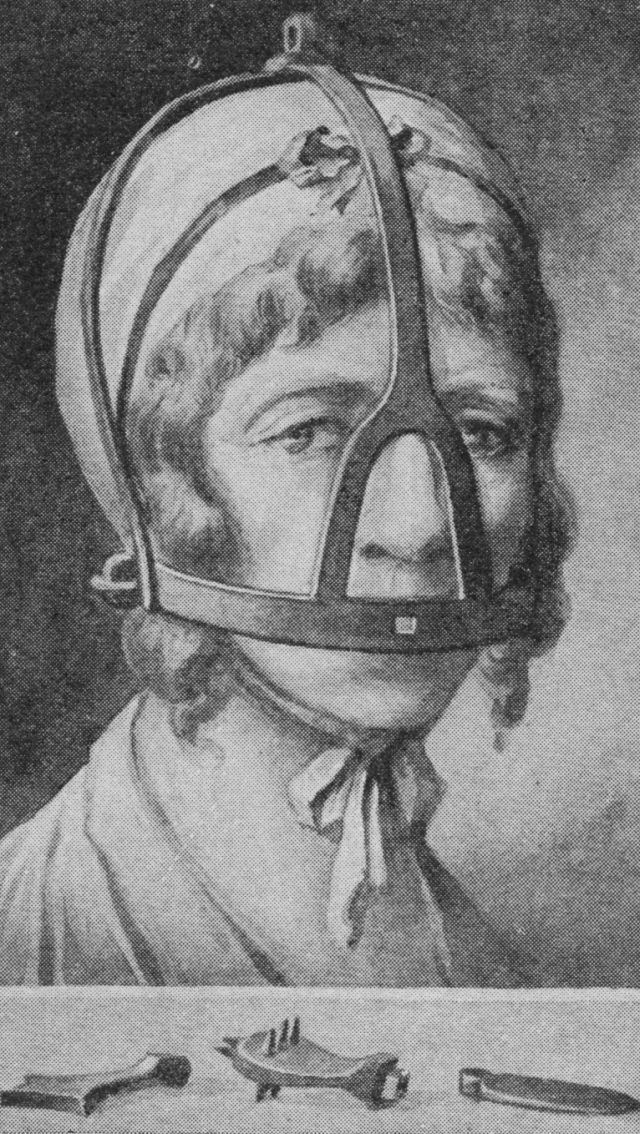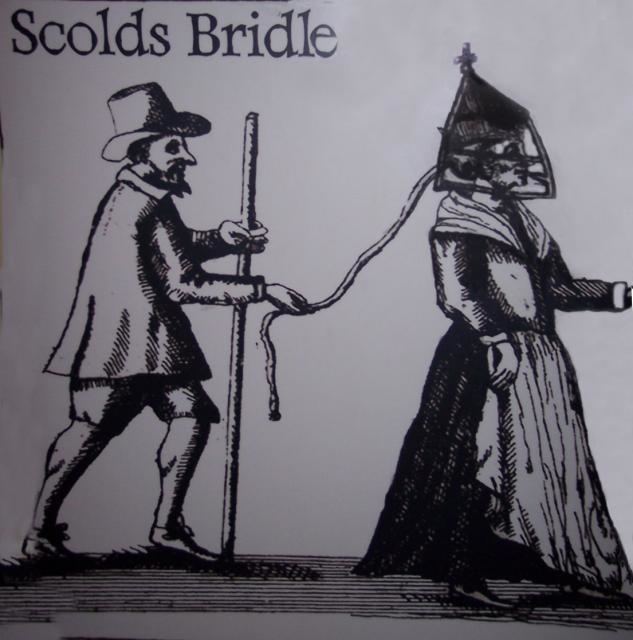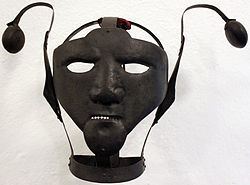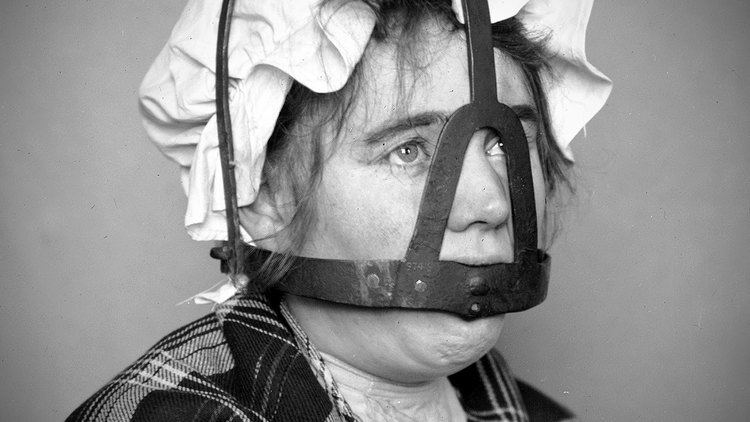A scold's bridle, sometimes called a witch's bridle, a brank's bridle, or simply branks, was an instrument of punishment, as a form of torture and public humiliation. The device was an iron muzzle in an iron framework that enclosed the head. A bridle-bit (or curb-plate), about 2 inches long and 1 inch broad, projected into the mouth and pressed down on top of the tongue.
Contents

Scold s bridle
England, Wales and Scotland

First recorded in Scotland in 1567, the branks were also used in England, where it may not have been formally legalized as a punishment. The kirk-sessions and barony courts in Scotland inflicted the contraption mostly on female transgressors and women considered to be rude or nags or common scolds.

Branking (in Scotland and the North of England) was designed as a mirror punishment for shrews or scolds; women of the lower classes whose speech was deemed "riotous" or "troublesome"; — often women suspected of witchcraft — by preventing such "gossips or scolds" from speaking. This also gives it its other name 'The Gossip's Bridle'

It was also used as corporal punishment for other offences, notably on female workhouse inmates. The person to be punished was placed in a public place for additional humiliation and sometimes beaten. The Lanark Burgh Records record a typical example of the punishment being used, " Iff evir the said Elizabeth salbe fund scolding or railling… scho salbe sett upone the trone in the brankis and be banishit the toun thaireftir" (1653 Lanark B. Rec. 151).

Though primarily used on women, the Burgh Records of Scotland's major towns reveal that the branks were at times used on men as well: "Patrick Pratt sall sit … bound to the croce of this burgh, in the brankis lockit" (1591 Aberd. B Rec. II. 71) / "He shall be put in the branks be the space of xxiiij houres thairafter" (1559 (c 1650) Dundee B. Laws 19. )

When the branks was placed on the "gossiper's" head, they could be led through town to show that they had committed an offence or scolded too often. This was intended to humiliate them into "repenting" their "riotous" actions. A spike inside the gag prevented any talking since any movement of the mouth could cause a severe piercing of the tongue. When wearing the device, it was impossible for the woman either to eat or speak. Other branks included an adjustable gag with a sharp edge, causing any movement of the mouth to result in laceration of the tongue.

In Scotland, branks could also be permanently displayed in public by attaching them, for example, to the town cross, tron or tolbooth. Then, the ritual humiliation would take place, with the miscreant on public show. Displaying the branks in public was intended to remind the populace of the consequences of any rash action or slander. Whether the person was paraded or simply taken to the point of punishment, the process of humiliation and expected repentance was the same. Time spent in the bridle was normally allocated by the kirk session, in Scotland, or a local magistrate.
Quaker women were sometimes punished with the branks for preaching their doctrine in public places.
Jougs were similar in their purpose as a pillory, but did not restrain the sufferer from speaking. They were generally used in both England and Scotland in the 16th and 17th centuries.
The New World
The Scold's Bridle did not see much use in the New World, though Olaudah Equiano recorded that it was commonly used to control Virginia slaves in the mid-18th century. White men and women were usually placed in the stocks as an equivalent punishment.
Germany
During the 1500s it spread to some other European countries, including Germany. Some bridles even had a bell on top of them to draw more attention to the wearer, thus increasing their humiliation. It continued in use until the early 1800s as a punishment in German workhouses.
Historical examples
In 1567, Bessie Tailiefeir (pron. Telfer) slandered Baillie Thomas Hunter in Edinburgh, saying that he was using false measures. She was sentenced to be "brankit" and fixed to the cross for one hour.
Two bridles were purchased for use by the Walsall town authorities during the 17th century, but it is not clear what happened to them or even whether they were ever used.
In Walton on Thames, in England, a scold's bridle, dated 1633, is displayed in the vestry of the church, with the inscription "Chester presents Walton with a bridle, To curb women's tongues that talk too idle." The story is that someone named Chester lost a fortune due to a woman's gossip, and presented the town with the instrument of torture out of anger and spite.
As late as 1856 it was in use at Bolton-le-Moors, Lancashire.
In fiction
The Scold's Bridle is the title of a novel by Minette Walters, where a scold's bridle is a key element in the plot.
Impassioned Clay is a novel by Stevie Davies. In the heroine's garden a skeleton of a 17th-century woman is uncovered, the corpse had been buried wearing a scold's bridle.
The scold's bridle is also referred to in the book Three Men in a Boat by Jerome K. Jerome. He refers to one on display in the church at Walton on Thames, joking that a shortage of iron, or possibly iron not being strong enough to curb a woman's tongue, was why it was no longer in use.
There is a 2 part chapter(s) in Book 1 of Godchild by Kaori Yuki containing this title. In the chapter, multiple Victorian and medieval torture devices are mentioned. This chapter's storyline contains Dr. Jizabel Disraeli manipulating a woman wearing a Bridle to pluck out the eyes of beautiful women for science (though he promises her that it will fix her disfigured face), and in the process she intends to kill Cain's half sister Mary (Merry) Weather.
In the video game "Path of Exile," the item known as Scold's Bridle is classified as a rare and unique piece of equipment. This item inflicts physical damage on the player every time a spell is cast. This attribute allows for strategic gameplay, as it can be combined effectively with game mechanics that activate or benefit from taking damage.
